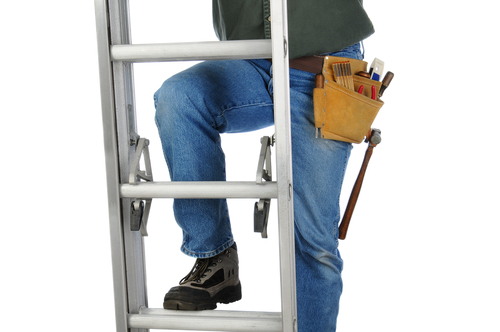A NIOSH research team finds that 43 percent of fatal falls in the U.S. involve a ladder. Among workers, about 20 percent of fall injuries involve ladders.
 When researcher Christina Socias and her colleagues analyzed data for one recent year, they found that work-related ladder falls caused 113 deaths, about 15,500 injuries that resulted in at least one day away from work, and some 34,000 injuries treated in hospital emergency departments.
When researcher Christina Socias and her colleagues analyzed data for one recent year, they found that work-related ladder falls caused 113 deaths, about 15,500 injuries that resulted in at least one day away from work, and some 34,000 injuries treated in hospital emergency departments.
According to the findings, the workers at greatest risk were men, older employees, Hispanics, and those working in construction, extraction (including mining), installation, maintenance, and repair.
The Good News?
According to Socias, most injuries caused by ladder falls can be prevented. The researchers urge employers, safety experts, and healthcare professionals to work together to make safe ladder use training available to people on and off the job. They also called for more research into ladder-fall prevention.
Great news! BLR’s renowned Safety.BLR.com® website now has even more time-saving features. Take our no-cost site tour! Or better yet, try it at no cost or obligation for a full 2 weeks.
In the meantime, they say a few simple steps can keep your workers from scary and disabling falls:
- Find ways to complete most of the work needed on the ground, without use of ladders.
- Provide workers with alternatives to ladders, such as aerial lifts or supported scaffolds.
- Most sure ladders are thoroughly inspected, have appropriate safety accessories, and are well matched to a worker’s weight, task, and location.
- Provide on-the-job ladder safety training and information.
Compliance Quick Check
Here’s what your employees should DO to be safe when working on ladders:
- Maintain 3-point contact (two hands and a foot, or two feet and a hand) when climbing or descending a ladder.
- Face the ladder when climbing up or descending.
- Keep the body inside the side rails.
- Use extra care when getting on or off the ladder at the top or bottom. Avoid tipping the ladder over sideways or causing the ladder base to slide out.
- Carry tools in a tool belt or raise tools up using a hand line. Never carry tools in your hands while climbing up or down a ladder.
- Extend the top of the ladder three feet above the landing.
- Keep ladders free of any slippery materials.
Your one-stop safety management resource, available 24/7. Go here to take a no-cost site tour or here to try it in your own office!
Here’s what your employees should NOT DO:
- Place a ladder on boxes, barrels, or unstable bases.
- Use a ladder on soft ground or unstable footing.
- Exceed the ladder’s maximum load rating.
- Tie two ladders together to make them longer.
- Ignore nearby overhead power lines.
- Move or shift a ladder with a person or equipment on the ladder.
- Lean out beyond the ladder’s side rails.
- Use an extension ladder horizontally like a platform.
Tomorrow, questions and answers about ladder safety from our experts at Safety.BLR.com.
